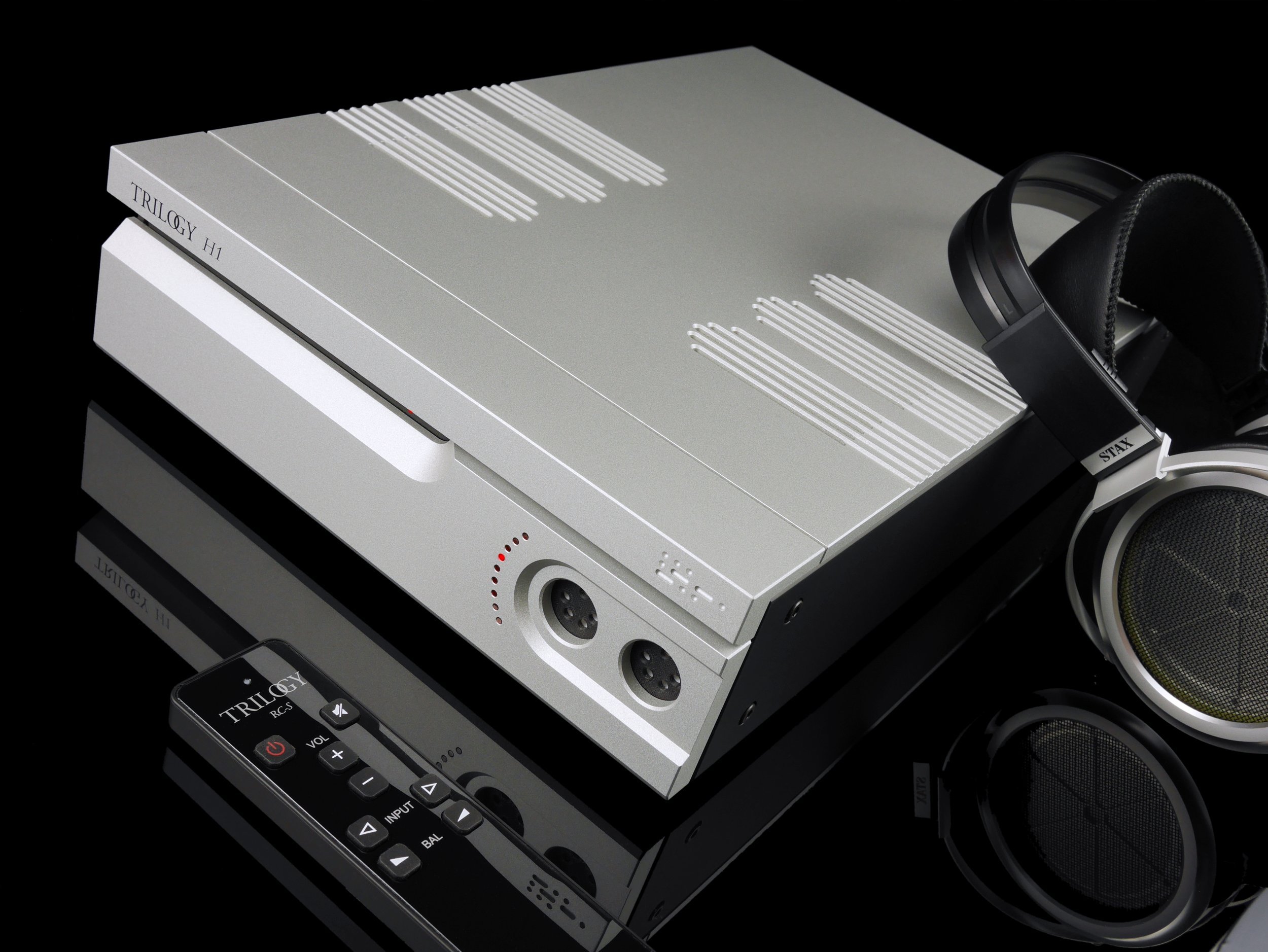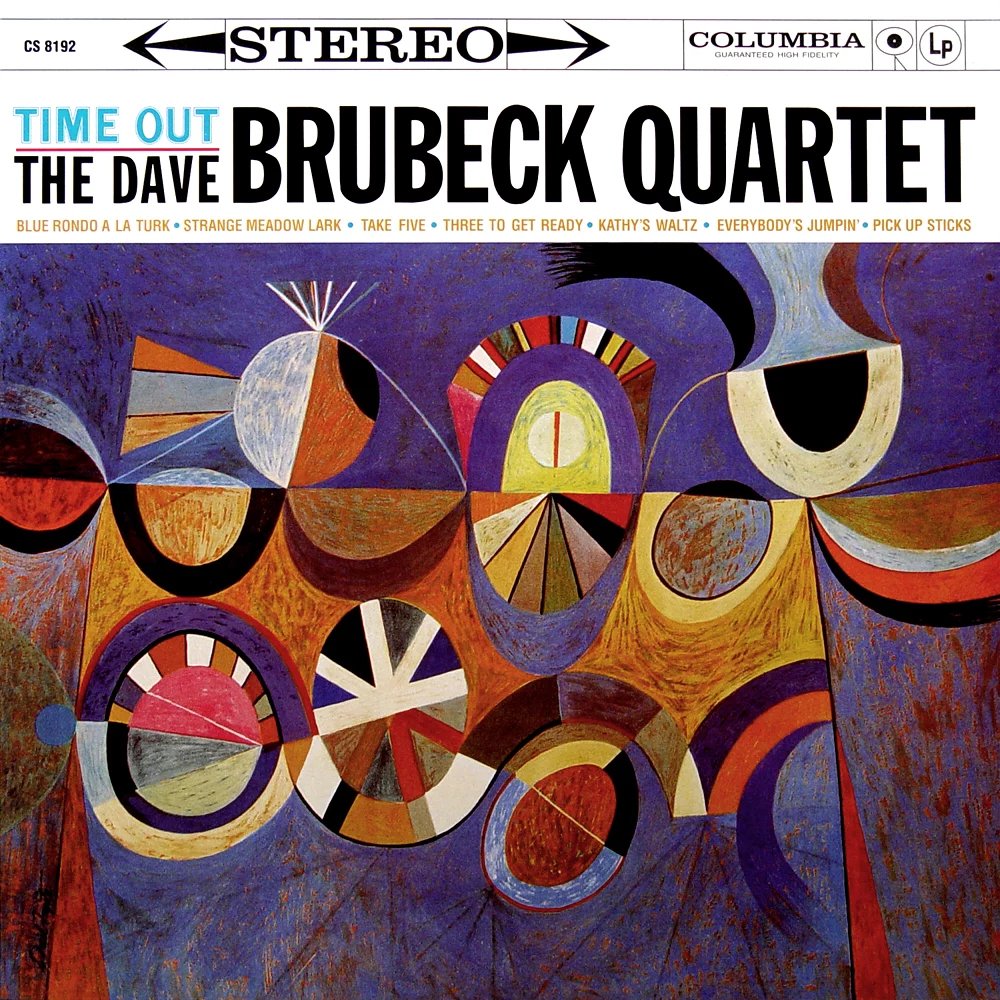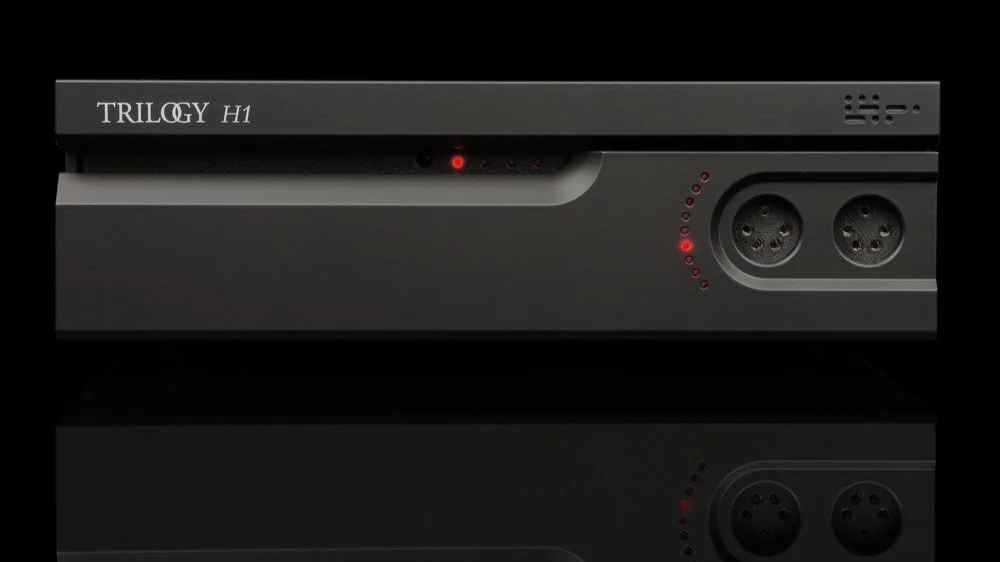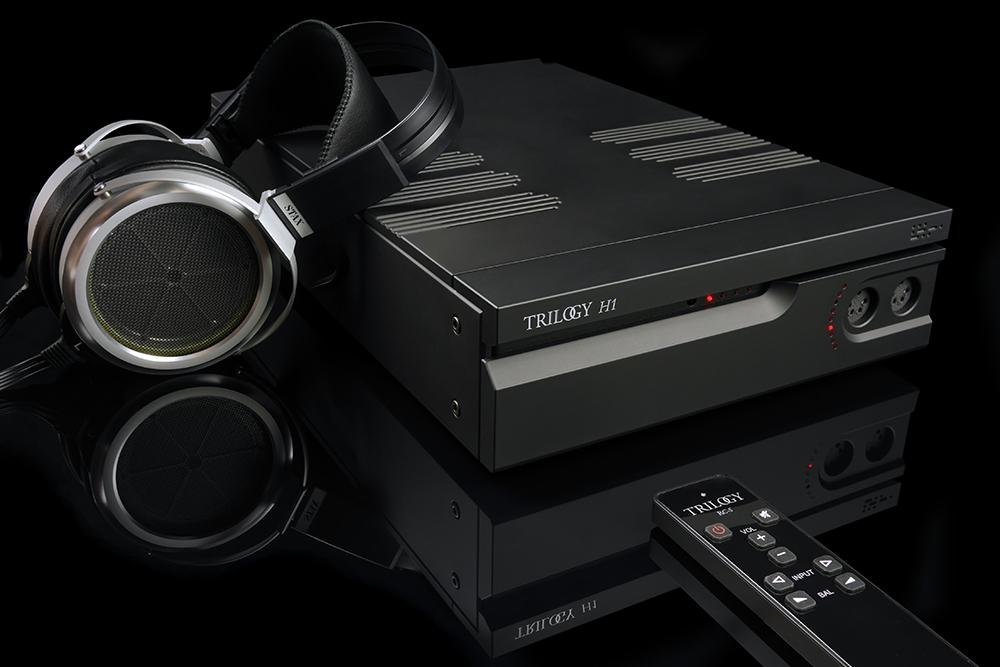TRILOGY H1 ENERGIZER - REVIEW
TRILOGY H1 ENERGIZER HPA\E
Once more into the breach or in this case into the world wherein electrostatics live, make music, entertain, and, dare I say, win converts continually. I’ve been traveling to this electrostatic world now for nearly three years and I am regularly astounded, surprised, jubilant to discover the diversity, talents, in short, the collective wherewithal of the various inhabitants—electrostatic headphones and electrostatic headphone amplifiers— of this world.
I have known electrostatic speakers for some time and have been quite taken with their abilities to reproduce music, but for some reason I have not spent much time with them. They are certainly part of the electrostatic world, but different, and their continent lies far flung, is sparsely populated and fairly difficult to gain admission to. Also, they are not as, well, personable as this world’s other offerings. In truth, they are a little bit standoffish, as they engage one from, literally, several feet away.
On this particular journey I travel to Trilogy where I engage the Trilogy H1 electrostatic energizer with a couple of old friends —STAX SR-009S and the Dan Clark VOCE. We, of course, wait patiently for the STAX SR-X9000 to return. There is one thing that I must again mention and that is that the combination of electrostatic headphone and headphone amplifier can become a sort of time machine. “A time machine” you ask? Yes, for their preternatural ability to transport one to the time, space or venue of a given recorded performance, an ability which is truly uncanny and quite glorious. As I had mentioned in an earlier review:
“Yes, equipped with a good to great electrostatic headphone, a good to great electrostatic ‘energizer’/headphone amplifier, and a comfortable chair, you are off across time and space discovering a plethora of musical venues—recording studios, stadium concerts, jazz cafes, symphonies, small classical quartets, etc—as if you were seated in them.”
So you ask, “How is the Trilogy electrostatic country different from the others? How is it alike? What is its landscape? Is it a place that you might be able to call home?”
REFRAIN: Unlike most reviews, this review will be non-sequential, as it will start, below, with how the equipment actually sounds and not the process of physically “undressing” it and/or laying out its various parts, specifications, etc. Think of this review then, as a non-linear movie—Memento, Kill Bill, Arrival, Eternal Sunshine of the Spotless Mind, The Terminator, In the Shadow of the Moon, The Queen’s Gambit, etc—that, likewise, starts at the end and winds its way to the beginning.
The Sound
Imagine this. All the transparency, resolution, detail retrieval, and coherency of an electrostatic rig—headphone and amplifier (energizer)—and the ease and beauty and profound musicality of a single-ended triode amplifier. If you can work that out in your mind—the tacit, intermingling dualities, the incongruities, the profoundly seductive engagement on offer, then you will have some idea of the Trilogy H1 Energizer and its country. Perhaps you won’t be prepared for it. I wasn’t. What did I know of Trilogy, prior to visiting? Nothing.
At times when listening, I’d imagine single-ended triode or, perhaps, analog of the master tape variety as wed to electrostatics. The listening experience was always unique and compelling. And I have listened to a great many electrostatic headphone amplifiers from the Viva Egoista STX ($17,000) to the Blue Hawaii Special Edition (BHSE) ($6,990) to the STAX SRM-T8000 ($6,000) and a great many others. Each, of course, had its attendant strengths, though to cite a ‘weakness’ in any would be a misnomer, as they all ranged from quite good to exceptional.
The Trilogy H1 was different again. It was every bit as commanding and musical, natural and prodigiously detailed, but, perhaps, even more gripping, more inherently musical than its brethren. It was as though the music simply took you over.
The Trilogy H1, however, did not offer the incredible clarity of the Viva Egoista STX or its openness, but it was closer in quality than one would have expected, and at a fraction of the cost. The BHSE went more deeply and easily into the sub-bass region and was incredibly musical but then it does employ a pentode (BHSE) versus triode (H1). However, other electrostatic amps, all exceptionally detailed, coherent, and musical, did not command so expertly the musical ‘traits’ of the Trilogy H1. At one point, I found myself rising to change the record! There was, of course, no record. Amazing!
All the usual suspects were lined up for the Trilogy H1’s examination and one after the other there was, well, more musical engagement with each piece. ‘Sublime-momentary-catatonia’ gave way to ‘Sublime-long-term-catatonic-shock’ wherein disbelief was constantly suspended, for long bouts. Was it the six triode tubes (4 × 6C3PI, 2 × 6H6PI)? Most probably. Suffice to say that tone and timbre are natural, beautiful, rich, edible.
The Trilogy H1’s volumetric cube—its soundstage—is exceptional. Its ability to render depth and width is rivaled only by the Viva Egoista STX and equaled by the BHSE. Its ‘layout’—layering, placement, separation—of performers on a stage is exacting and solid. The Trilogy H1 reveals space via endless microdynamic details, nuance, and spatial cues which made venues real and believable, in a continual ‘you-are-there’ manner.
The Trilogy H1 was paired with the Grimm Audio MU1 streamer, the Mola Mola Tambaqui DAC, the DENAFRIPS Terminator II DAC, STAX SR-009S, and the Dave Clark VOCE electrostatic headphones. Audience Front Row cables/wires and RSX power cords handled their respective duties. The Audience AdeptResponse aRS-T4 provided service as the power conditioner.
TREBLE+
Spaciousness. Ease. Finesse. Resolution. Musicality. Air. Dave Brubeck’s “Take Five” (Time Out, Columbia-Legacy, CD) sits ready to join the mix. What can I say? When an album is so familiar to you and helps to provide insight on treble resolution, transient speed, and even discerns phase—if Joe Morello’s drum kit is in the right channel your system is out of phase (or something therein is)—you use it. Suffice to say that the Trilogy H1’s portrayal of this track is spot on with regard to the drum kit and its cymbals and their master-tape-like high-fidelity. Does it get any better? Yes, it would if the STAX SR-X9000 headphones were in the house, though the STAX SR-009S is also no slouch, despite having relinquished its top position. Hilary Hahn’s “V. Chaconne from Partita No. 2 for Violin in D minor, BWV 1004” (The Essential Hilary, Sony Classical) comes alive, while the venue and the air within the space have never been more present, more participatory. And the tone and timbre of Hilary’s violin are natural, rich, attention grabbing in their verisimilitude via the Trilogy H1, like never before. Where the Viva Egoista STX brought unmatched clarity via its 300B tubes, the Trilogy excels in richness, a natural realism in a way that asks yet again, “should I get up and change the record?” when, again, there is no record to change.
Midrange
Spacious. Natural. Analog. Unendingly detailed. Musical. There is an ease that permeates the Trilogy H1’s rendering of music. Perhaps it is extreme confidence in its abilities, a ready ease with all manner of recordings, or perhaps it is just its nature. As most probably know, electrostatics, in general, have no peer when it comes to the playback of live events, choirs, large reverberant, air-filled venues, etc. This fact has kept me at a distance from these types of recordings when not using ‘electrostatics’, with two exceptions—playback of said material on an exceptional headphone amp with either the Abyss AB1266 Phi TC or the ZMF Atrium.
Suffice to say that choral music and, in particular, Voces8, a UK based choral group, were back on the menu. I happily queued up “Agnus Dei” (Enchanted Isle, Decca) for play. Ethereal, the soprano’s voice soars, the massed voices, tonally captivating, accompany beautifully, and St. George’s Church, Chesterton, Cambridge, England lends its volume and air as canvas to their voices. The Trilogy H1 excels in this reproduction and in all the other pieces across this album. Sublime. Of course, Muddy Waters Folk Singer (Geffen) was inevitable, the pious and the not so pious in a rather dramatic counterpoint. “My Home in the Delta” opens and it is a time-machine transportation to the venue, to witness Muddy and company in the throes of singing the blues. “Hot dog” it is more ‘real’ than it has ever been.
BASS
Tight. Energetic. Blistering dynamics. Daunting musicality. Eiji Oui’s “Infernal Dance of King Kashchey” (Stravinsky, Reference Recording) is queued for play and opens with…well, a not so steep dive into the sub-bass strata, though the upper bass and mid bass regions are handled beautifully. There is a reason that I select this piece for bass and sub-bass evaluation and that is because it can be a torturous track. First, it was produced/recorded quite low or so it seems. You’ll need to adjust the volume 6, 7, 8 possibly 9 steps higher, depending on the amplifier, to arrive at a ‘simulacrum’ of the orchestra’s ‘effective’ loudness. This is where a steep sub-bass dive is absolutely necessary. And while a good number of components achieve it, a good number do not. The Trilogy H1 handled all of the other usual bass suspects—Marcus Miller’s “Power” (M2, Concord), Massive Attack’s “Angel” (Mezzanine, Circa), David Holland’s “B-40/M23-6K/RS-W” (Emerald Tears, ECM), Malia and Boris Blank’s “Celestial Echo” (Convergence, Boutique)—beautifully. The Trilogy H1 could not, however, reach into the seven-tympani-strong sub-bass or deep-bass strata for the “Infernal Dance of King Kashchey”. This is its limitation: it expertly handles the mid and upper bass, and even the initial steps of the deep bass regions remarkably well and beautifully, though not the deepest bass.
The Wrappings and Accessories
A nondescript, thick, brown, outer box with a nicely stylized TRILOGY logo and accompanying marketing information lie across four of its sides.
The inner box, held in place by two long foam braces, however, is completely nondescript, bereft of markings of any kind. The epitome of minimalism.
The inner box holds the Trilogy H1 Energizer wrapped in a foam sheet, a power cord, and a remote control.
Utilitarian minimalism, its purpose clearly defined—to protect the Trilogy H1 at all cost (save multistorey drops, trains, etc).
Design—Look, Feel, and Technology
Modern. Svelte. Aesthetically clean. The Trilogy H1 Energizer is exceptionally well executed from an industrial design, functionality, and overall aesthetic perspective. The H1 comes in black or silver (shades of the Oakland Raiders).
The Trilogy H1 at 3.47” high carries a form that can fit on just about any rack, shelf or desktop and its depth, just under 16”, will make this doubly so. And its weight, at nearly 15 pounds, represents easy out-of-box pickup and placement.
Its front facade personifies minimalism with red lights, hidden under a protruding brow, and two electrostatic headphone outputs on its far left side. The leftmost headphone output is lined up beside a concave wall of red light that indicates volume level. Its top features on both the left and right sides, near the H1’s front face, three heat vents shaped much like the tubes beneath them, a very nice touch. And its back facade is quite functional (see Functionality).
The Trilogy H1 is the embodiment of a well executed, industrially designed product, whose minimalism forms a clean, beautiful aesthetic.
Trilogy H1 Energizer HPA\E
Dimensions: 260 x 405 x 88 (WxDxH)
Weight: 6.7kg
Power Consumption: 55 Watts
Power Consumption (standby): 1 Watt
Inputs: 4 source inputs —2 RCA, 2 XLR
Outputs: 2 × Five Pin Stereo Electrostatic Headphone Jack connectors
Gain Max: 56dB
Frequency Response: 10-50kHz +/-0.5dB
Phase: Phase correct (non-inverting)
Tube complement: 4 × 6C3PI, 2 × 6H6PI
Bias Voltage: 580VDC
Operation: Class A operation
FUNCTIONALITY
The Trilogy H1, armed with a full-function remote control, is a piece of pie to operate—cherry pie. On/Off, volume, input, balance, mute rest in the palm of one’s hand and prior to that it’s plug and play. I was up and running in a little under five minutes.
The Trilogy H1’s front face as earlier mentioned could not be more, well, minimalist. There are no buttons, toggles, switches, or knobs on its front face, other than the two headphone outputs. And the lit red light under the top brow indicates the active source, while the red light beside the leftmost headphone output the volume level. Nice.
The back facade of the Trilogy H1 features from left to right the IEC/Power socket, 2-XLR inputs for the right channel, 2-RCA inputs for the right channel, then 2-XLR inputs for the left channel, 2-RCA inputs for the left channel. You heard that right folks—two XLR inputs, a reviewer’s dream (for balanced comparisons)! And that’s all she wrote for the back of the H1. Don’t you just love the minimalism? I do.
Conclusion
I have become very familiar with electrostatic headphones and amplifiers (energizers) as I have traveled to the electrostatic world quite often and happily so. Visiting it has vanquished the belief that musical beauty and technical prowess—resolution, transparency, detail retrieval, immaculate staging—had to be, more often than not, mutually exclusive. They are not, at least, not on this world. And I have also long known single-ended triodes across an array of vacuum tubes—300B, 845s, 2A3s, 211s, EL34s, etc—implemented across an array of amplifiers for their tonal/timbral beauty and richness. The ‘marriage’ of the two with sufficient power reserves to drive one’s headphones is sublime in the extreme. Though the ability to acquire the Holy-Bass-Head-Grail, at the limits of the sub-bass strata appears to be the Trilogy H1’s only limitation. And yes, I reversed the order of the frequency reviews, as a dedicated ‘dessert first’ issue, so as to outline its truly outstanding way with, well, everything else.
The Trilogy H1 energizer is the child of electrostatics and single-ended triodes and it is sublime in the extreme. Did I mention the Trilogy H1’s blazing, transient speed, its openness, its hypnotic immersiveness, and delicious tonality? “Yes.” Well, okay.
That this is a first outing for Trilogy in the electrostatic realm is remarkable and speaks to a well researched and developed first electrostatic product. That it is not more widely known is only temporary, in this reviewer’s opinion.
I happily award—the GOLD KEYNOTE AWARD— to the Trilogy H1, an exceptional electrostatic headphone amplifier.
Pros: Transcendent ability to bring forth the music and the attendant parameters of high fidelity music reproduction in a most sublime manner. Incredibly delicious midrange, extended silky treble, potent upper and mid bass. Two (2) XLR inputs!
Cons: Sub-bass reach.
THE SYSTEMS
Aurender N30SA
Bricasti Design M1SE DAC
Mola Mola Tambaqui
Dan Clark VOCE
STAX SR-009S
Audience Front Row Cables
RSX Power Cables
Audience AdeptResponse Power Conditioner
2.
Grimm Audio MU1
DENAFRIPS Pontus II
DENAFRIPS Terminator II
Dan Clark VOCE
STAX SR-009S
Audience Front Row Cables
RSX Power Cables
Audience AdeptResponse Power Conditioner
The Company
TRILOGY AUDIO
Trilogy H1 Energizer HPA\E:
$6,850 (USD) for Silver
$7,250 (USD) for Stealth Black
www.trilogyaudio.com
sales@trilogyaudio.com







